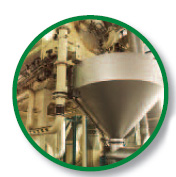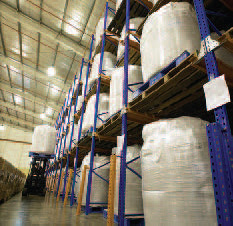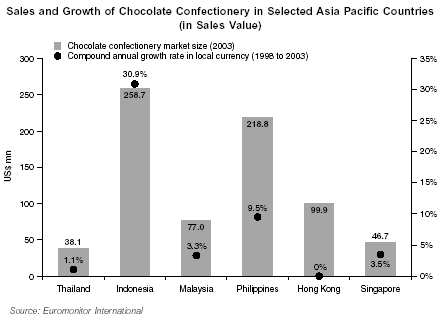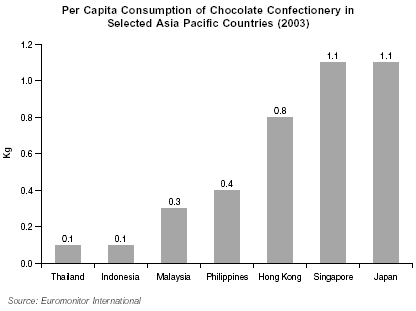This printed article is located at https://delfilimited.listedcompany.com/industry.html
Industry Trend
 Cocoa ingredients are supplied to consumer product manufacturers in the food and beverage industry
as well as industrial chocolate manufacturers. Consumer chocolate manufacturers produce branded
chocolate and chocolate confectionery products. Industrial chocolate manufacturers supply couverture
and other chocolate products to chocolate manufacturers as well as to food and beverage
manufacturers who use industrial chocolate as an ingredient, such as in biscuits, ice-cream and baking
products.
Cocoa ingredients are supplied to consumer product manufacturers in the food and beverage industry
as well as industrial chocolate manufacturers. Consumer chocolate manufacturers produce branded
chocolate and chocolate confectionery products. Industrial chocolate manufacturers supply couverture
and other chocolate products to chocolate manufacturers as well as to food and beverage
manufacturers who use industrial chocolate as an ingredient, such as in biscuits, ice-cream and baking
products.
Historically, the majority of chocolate manufacturers were vertically-integrated and had cocoa processing operations. Large consumer chocolate companies integrated upstream to secure raw materials and protect the secrecy of their recipes. However as global competition placed greater demands on branding, marketing and product innovation, these vertically integrated chocolate manufacturers faced increasing pressure to focus on their core consumer businesses.
Many such companies have progressively reduced or stopped further investments in cocoa processing, gradually withdrawing from upstream activities and outsourcing the production of cocoa ingredients to specialised cocoa processing companies. The production of cocoa ingredients like cocoa powder and cocoa butter is highly capital intensive and becoming increasingly sophisticated, requiring continual investments in research and development and manufacturing know-how in order to keep pace with competition.
Outsourcing such activities helps free up cash flow which can then be invested more profitably in product development and promotional campaigns for their core consumer businesses. The emergence of specialised and cost-efficient cocoa processors that are able to supply cocoa ingredients which meet stringent quality and consistency requirements of large chocolate manufacturers has also contributed to the trend of outsourcing.
For cocoa processors, the need to gain scale in order to be more cost efficient has led to a period of consolidation. We believe that as a result of mergers and acquisitions that have taken place over the last decade, a number of large scale companies have been formed and have raised the barriers to entry in the cocoa processing industry.
Global Consumer Chocolate Confectionery Market
 According to Euromonitor International, the global market for chocolate confectionery in 2003 was
approximately US$62.4 billion, accounting for more than 50% of global confectionery sales in terms of
retail sales value.
According to Euromonitor International, the global market for chocolate confectionery in 2003 was
approximately US$62.4 billion, accounting for more than 50% of global confectionery sales in terms of
retail sales value.
Over the five-year period from 1998 to 2003, global chocolate confectionery sales have experienced compound annual growth rates of 3.0% in value terms and 1.5% in volume terms (Source: Euromonitor International). Consumption of chocolate confectionery has traditionally been concentrated in developed markets such as Western Europe and North America. Sales and consumption of chocolate confectionery in developing markets have generally been inhibited by poor retail infrastructure, climate as well as affordability.
Rising affluence and disposable income and the rapid development of modern retail trade such as airconditioned supermarkets and convenience stores has had a positive impact on the growth in consumption of chocolate confectionery in developing countries. In addition, product innovation and the development of products and packaging better suited to the climates in less temperate developing countries have also had a positive influence on consumption.

Global Consumer Chocolate Confectionery Market
The chocolate confectionery market in the Asia Pacific has experienced significant growth in the period from 1998 to 2003. Retail sales of chocolate confectionery in the Asia Pacific has grown from approximately US$4.5 billion in 1998 to approximately US$5.6 billion in 2003. The chocolate confectionery market in the Asia Pacific has grown at a compound annual rate of 4.4% in terms of sales value and 5.6% in terms of sales volume over the same period. (Source: Euromonitor International).


Chocolate Confectionery Market In Indonesia
The chocolate confectionery market in Indonesia has experienced significant growth in recent years. According to Euromonitor International, Indonesia was one of the fastest growing countries globally in terms of chocolate confectionery sales over the five year period from 1998 to 2003. Retail sales of chocolate confectionery in Indonesia was approximately Rp2.2 trillion in 2003 and has grown at a compound annual rate of 30.9% and 23.9% in local currency value and volume terms respectively over the period from 1998 to 2003.

The rapid expansion of the modern trade, such as hypermarkets, supermarkets and convenience stores (more commonly known as mini-marts in Indonesia) has been a significant factor in the growth of the Indonesian chocolate confectionery market as increased accessibility, coupled with improvements in shelving and storage methods such as air-conditioned systems, have had a positive impact on the distribution of chocolate confectionery products. Other factors which we believe have positively influenced consumption growth in Indonesia, which has a population of approximately 220 million, include the increasing availability and affordability of chocolate confectionery products.
While the growth of the modern trade has helped spur chocolate confectionery sales, the traditional trade continues to be an equally important channel of distribution. Due to the scattered nature of these outlets, building an effective distribution network is difficult but crucial to gain access to the majority of consumers.
Chocolate confectionery products in the Indonesian market can generally be divided into three types:
- Moulded/Enrobed chocolate
- Dragees
- Specialties
- Moulded/Enrobed chocolate: 82.7%
- Dragees: 11.5%
- Specialties: 5.8%
Our branded chocolate confectionery and third party chocolate consumer products collectively accounted for a share of 56.9% of the urban grocery market for chocolate confectionery in Indonesia for the 12 month period ended March/April 2004 (Source: ACNielsen). The following table sets out the top four brands by value share of the urban grocery market for chocolate confectionery in Indonesia for the 12 month period ended March/April 2004:
